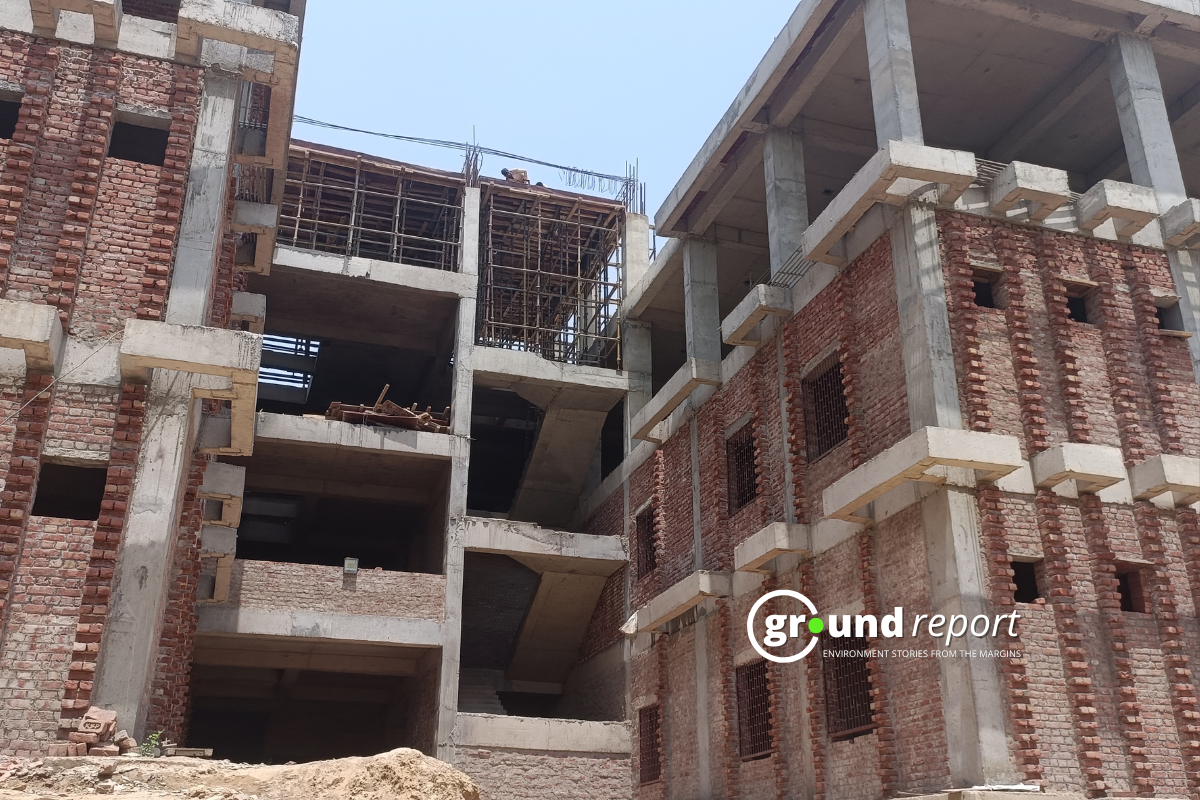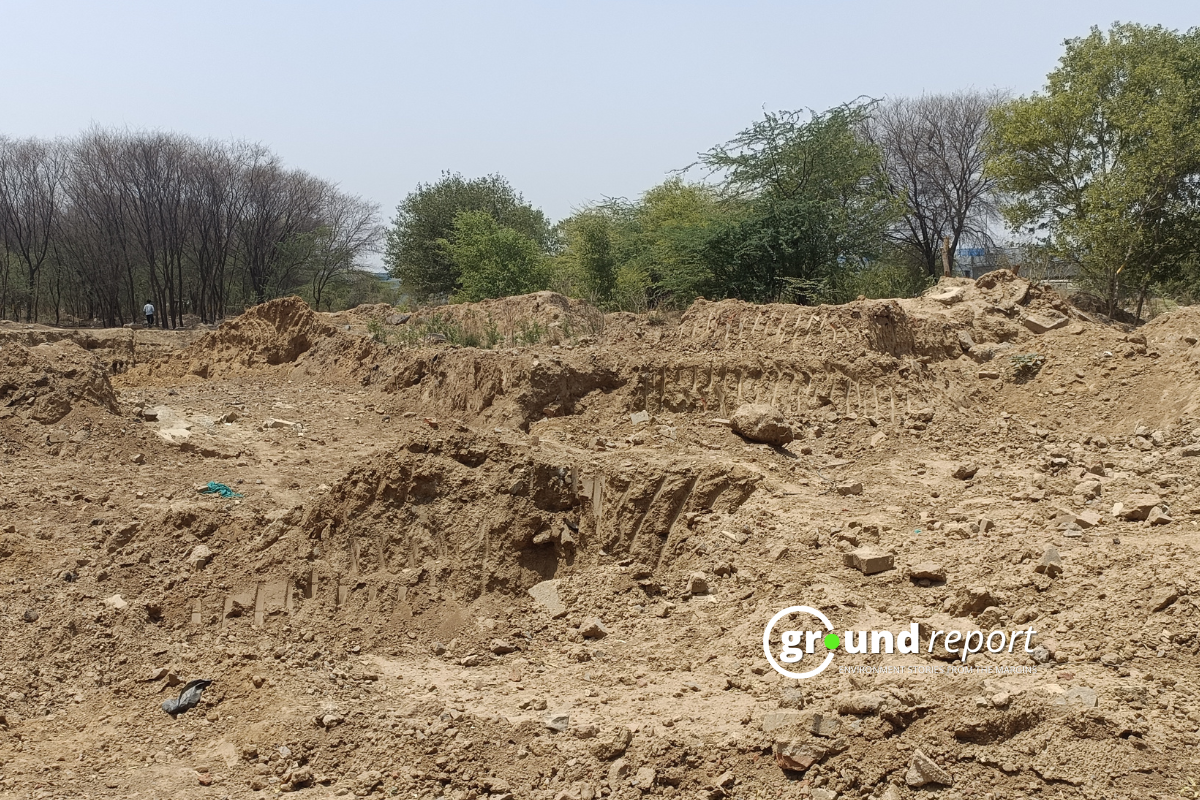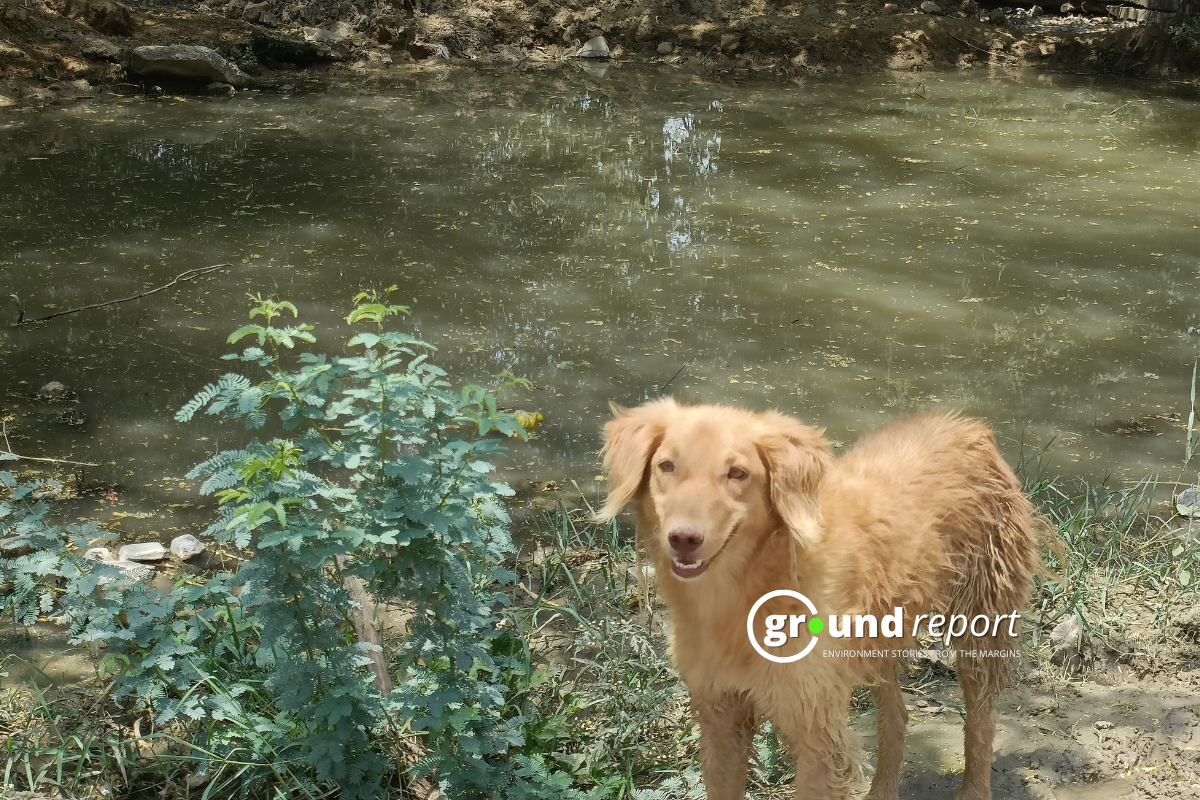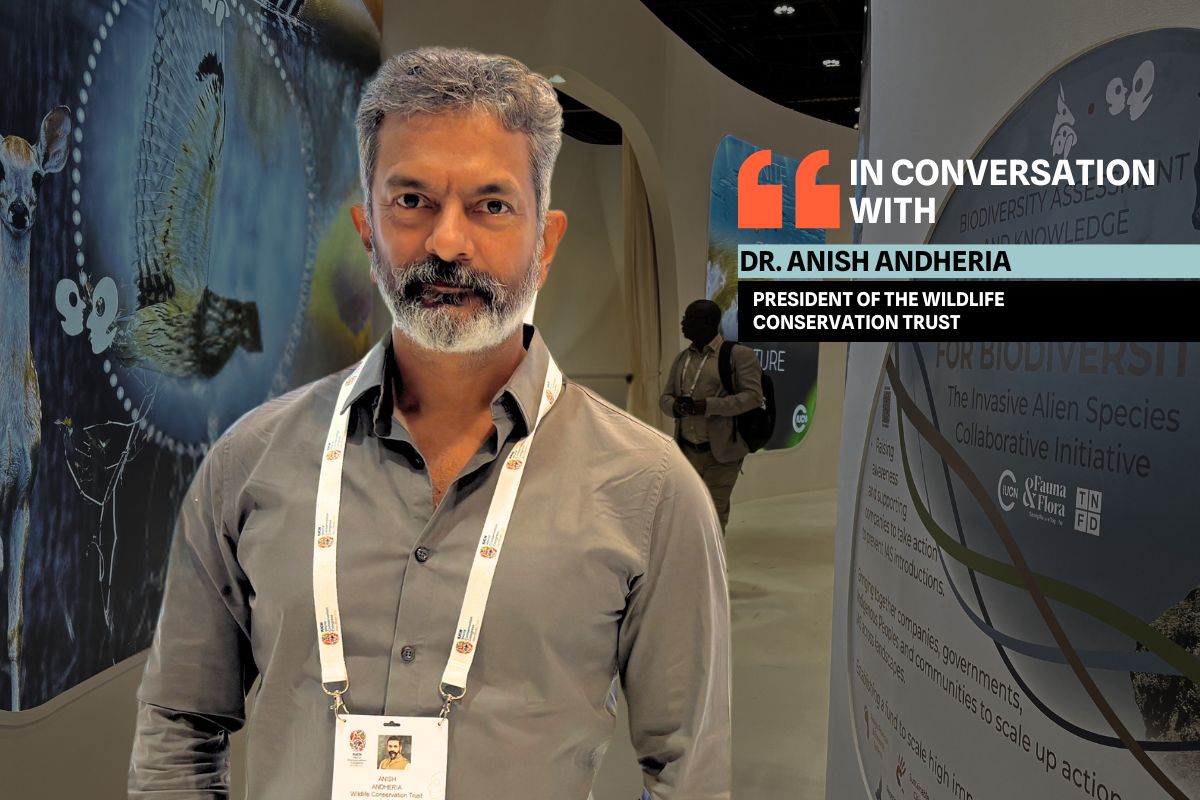Around 30 locals and activists gathered near Dwarka Sector-21 metro station in New Delhi to protest against the felling of trees inside the Dwarka Forest. Ankita Marwaha, 28, a resident of Dwarka, is visibly perturbed by urbanisation at the cost of a significant forest area.
“What is the point of having research institutes and structural analysis when we do only what is convenient, i.e. to cut everything down and build massive buildings,” she told Ground Report.
Dwarka Forest lies behind one of the busiest airport terminals in the world– Terminal 3 of Indira Gandhi International Airport (IGI), Delhi. According to an Environmental Impact Assessment Report, of Dwarka Sector 9 to IGI Airport, the ambient air quality data indicates a much higher value of suspended particulate matter (PM) than the prescribed limits established by CPCB at the monitoring station.
The Central Pollution Control Board (CPCB) recommends green belts for reducing air pollution in the human environment, particularly in industrial and urban regions. A US-based study suggests that small hairs on plant leaves, in particular, may play an important role in trapping the solid and liquid particles that comprise PM.

Lately, in India, ‘what is a forest’ is a subject of great debate. This is one such case. In times of climate crisis, any green cover with a flourishing ecosystem should be conserved. This might be an optimistic outlook, as paradoxically, development always comes at the cost of the environment, particularly, in urban areas. When the temperatures in the capital city are soaring, the remaining forests and water bodies demand protection. Hence, in early 2024, the apex court in a judgement asked the government(s) to use a broad definition for the term ‘forest.’
On the other hand, the citizen-led protests have increased with the demand to safeguard the green cover in urban areas. Similar gatherings, marches and more have to be organised for Mangar Bani, Aravalli Hills, Sanjay Van and other areas, mostly my youth.
Tanuja Chauhan, a resident of Noida, leads the social-media campaign to conserve the forest for the past year. Conveying the urgency of action to save the forest, she said,
“We are sitting on a ticking time bomb and would need an immediate stay on the cutting of trees. [It should have] a status of deemed forest.”

A deemed forest is not a reserve or a notified forest and different states have different definitions. In Delhi, any area over 2.5 acres with over 100 trees per acre is called a deemed forest. Similarly, 1 km stretches of roads and drains with the same density are also deemed forests. The concept came into existence following a Supreme Court order in the TN Godavarman case in 1996.
Chauhan reached out to numerous organizations working on environmental issues, particularly activism. Her efforts garnered support from Climate Front India and a few other organizations. However, the cutting of the trees continues. Now, as next steps, the #SaveDwarkaForest group will be filing a petition for a stay order on the construction project, along with a fellow advocate part of this drive.
Forest, beyond the definition
Any association with parks, forests, or green cover is more than just some legal definition. Malwaha shared fond memories of visiting the forest with her father to watch the birds and animals and cycling around the area with her friends.
“This is the area I have lived all my life and it is sad to see the forest vanishing and dust of the construction in the air now,” she added.
“Right now, we are trapped in fighting for a status of whether it’s a forest or not. But what matters is not the categorization of the area, it is the trees and this ecosystem which should be conserved,” Chahuan told Ground Report.
Malwaha while observing the digging, JCBs and labourers working inside the forest noted,
“The difference in the levels of land shows the burying of trees on one side and the digging of the sand for construction on the other. Meanwhile, the labourers working here are the same people who belong to the section of the society which is impacted disproportionately by climate change.”
Like Malwaha, many young protestors also recalled visiting the forest regularly, since their childhood. But, they acknowledge that the area is changing due to urbanisation at a rapid speed, mostly without the consent of the residents.
What is the issue?
The 120-acre land was acquired by the Delhi Development Authority (DDA) in the 1960s and again by the Rail Land Development Authority (RLDA) in around 2008. Naturally, the trees/plants started growing across a 2 km stretch. However, in 2021, RLDA started its Bijwasan Railways Redevelopment Project. The project includes a new terminal building of 30,400 square metres (sq m), an air concourse across 12,500 sq m and a circulating road network of 123,500 sq m. The new Bijwasan railway station will have eight platforms, against the current number of two.
For the project’s implementation, the RLDA’s contractors buried trees in the soil, instead of cutting or transplanting them. They didn’t have any valid permission to do so, till 2024. The Forest Department (FD) fined them around Rs. 5.93 crores in 2022, as it found 990 fallen trees at the project site. The RLDA paid up the fine but started cutting and concealing trees underneath, again. According to the locals, FD ignored all tree violation complaints till 2023.

NGT declared the land as non-forest land
In February 2024, the National Green Tribunal (NGT) declared the 120-acre patch a non-forest land. In the petition filed by RM Asif, a Delhi citizen, he requested the NGT to halt the project and stated that over 1,000 trees had been cut in the forest tract, a violation of the Delhi Preservation of Trees Act, 1994.
In a submission made in the first week of February, the forest department informed the NGT that the area was not a protected forest, but may be considered a deemed forest. However, the RLDA mentioned that the area can’t be considered a deemed forest for the following reasons.
“Counsel for respondent no. 1 (RLDA) has pointed out that DDA had handed over the possession of about 110.07 hectares of land to the Railways for Integrated Metropolitan Passengers Terminal (IMPT). He has also pointed out the plea of the applicant….that there are 1,100 trees on the subject land. Hence, he submits that on calculating the number of alleged trees standing on per acre of land…this land does not fall under the category of deemed forest,” said the NGT bench headed by Justice Prakash Shrivastava in its order on February 13, stating the recently amended Forest Conservation Act 2023 also did not cover deemed forests anymore.
“Six days after the NGT ruling on the forest, the Supreme Court of India gave back the protection status to deemed forests in the country. Before the NGT ruling, Dwarka forest, too, fell under the ‘Deemed Forest’ category,” informed a protester to Ground Report.
With many trees already cut and buried, Chauhan thinks it would be difficult to regain the status of deemed forest despite the SC order. She added,
“We are a bunch of young people and are learning how the legalities work. We all hope to conserve the remaining forest with all the knowledge we have.”
Cutting Trees and Climate Change
The trees are being removed at a quick pace. They were numbered sequentially in red and yellow, and some had white ribbons tied to them. According to a protester who has been actively involved in preserving the forest for the past two years,
“White ribbons denote that those trees will be chopped in the next few days and trees marked with red will also get cut after.”

According to locals protesting to save the forest, earlier the forest provided habitat to wildlife including 65 bird species, 50 antelope (Nilgai) individuals, wild rabbits, jungle cats, reptiles like Indian lizards, etc, and now has become a huge construction site. The are two water bodies which supply water for the woodland creatures. The rampant construction and resource extraction have impacted the water quality and diminished their size. Annual visits from the migratory birds to the forest during winter have visibly reduced for the last two years, the locals claim.

Youth-led protests and social media
The security measures in the area have been tightened over time. During our visit to the forest, we were approached by a security officer who verified our reasons for being there. According to Chauhan, just two days ago, fencing was done in a certain part of the forest to restrict people from assessing the developments. She also showed her concern about facing the powerful government,
“With BJP in power in Delhi, [the constructions are under central government projects], it would again be difficult to challenge it,” she added.
However, the young are utilising social media to garner attention and run awareness drives many issues, particularly, to protect the forest with #SaveDwarkaForest.
“Social media helps us mobilise, [and spread] the information about the issue and create awareness. But, [now] we need a legal safeguard to protect the remaining forest,” Marwaha added.
Another protester, who prefers to remain anonymous, visits the forest every other day. However, they continue to witness disheartening sights – more trees being felled, expansive areas cordoned off, construction workers labouring, and increased security measures. Previously, there was hope that the forest department would heed the locals’ concerns, but now there seems to be no dialogue, the protester informed us.
Ground Report has reached out to the Forest department. The story will be updated when they respond.
Keep Reading
Part 1: Cloudburst in Ganderbal’s Padabal village & unfulfilled promises
India braces for intense 2024 monsoon amid recent deadly weather trends
Support us to keep independent environmental journalism alive in India.
Follow Ground Report on X, Instagram and Facebook for environmental and underreported stories from the margins. Give us feedback on our email id greport2018@gmail.com.
Don’t forget to Subscribe to our weekly newsletter, Join our community on WhatsApp, and Follow our YouTube Channel for video stories.






